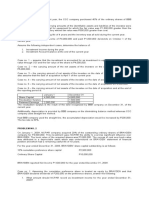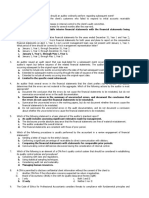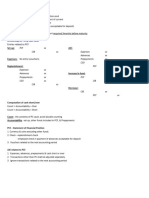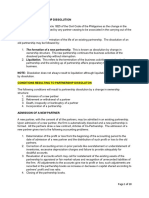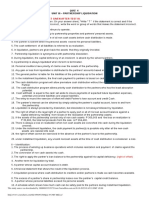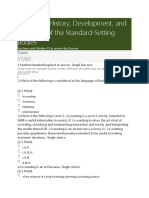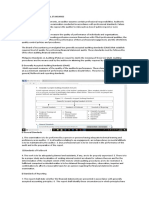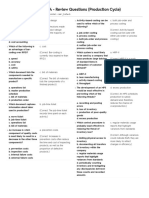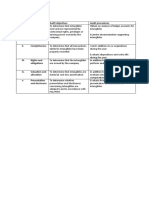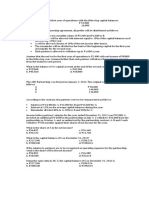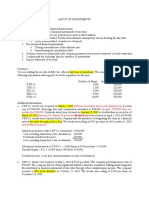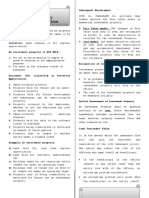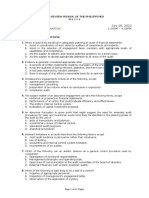0 ratings0% found this document useful (0 votes)
468 views50 pagesChapter 6 - Substantive Testing
A BOOK
Uploaded by
Alliah SepadaCopyright
© © All Rights Reserved
We take content rights seriously. If you suspect this is your content, claim it here.
Available Formats
Download as PDF or read online on Scribd
0 ratings0% found this document useful (0 votes)
468 views50 pagesChapter 6 - Substantive Testing
A BOOK
Uploaded by
Alliah SepadaCopyright
© © All Rights Reserved
We take content rights seriously. If you suspect this is your content, claim it here.
Available Formats
Download as PDF or read online on Scribd
You are on page 1/ 50
Comprchensoe Revi in Fading and
Asrarce Piaiples
‘appropriate decisions. In looking ap
and its intemal contro, the auctor, fe Pa
togenerate information and then conte .
parties who can make use oft, waite EY
ty
98 D
The auditors goal wes to eabich pg
of the design of the controls that: Were und
in place in tis payroll system, ap SUpece Shay
techniques (questionnaire, flowchart. gee onto rg
accompish tis purpose sucessful’ “7 @trati, these
one is necessary athough sometimes ¢"8Forg CA
are grouped together if the sytem ° techngtly |.
arti
r
complex. cass
99 c
Each of these four & an Hemal coq
frequently found in a company! ct
system, However, the ate eat designe ap P2YFal
or discover frauds of a specific type, jy,PTEvent
problem is extra hours claimed by an employee i «t®
umeamed money canbe received. Test data fe tae
to very that the payol program is. working oo
intended. The paymaster herds out cheques to make
certain that checks are being prepared for actual
individuals who work for the company. That is also
the case for folowing upon checks tat are not claimed
at the appropriate time. The approval by the
supervisor i correct here because the supervisor is the
person most likely to know how many hours. the
employee actually did work. That person io
postion to very thatthe number of hours fi
correct.
-cynov
CHAPTER 6:
SUBSTANTIVE TESTING PROCEDURES
(DITING STANDARD REFERENCE(S):
eas Audit Evidence
154501 - Audit Evidence — Specific Considerations for Selected Items
64505 - External Confirmations
PSA. aa) ~ Analytical Procedures -
pst 540 (Revised) — Auditing Accounting Estimates, induding Fair Value
nting Estimates and Related Disclosures
‘The auditor performs substantive tests to decrease the amount of detection risk
toan acceptable low level after considering inherent risk and control risk.
Substantive Test
> Audit procedures designed to detect material misstatements at. the
assertion level,
> Substantive procedures used by auditors could be either tests of details
or substantive analytical processes.
> The auditor's judgment on the expected effectiveness and efficiency of
the avallable audit procedures to reduce audit risk to an acceptable level
is used to determine which audit procedures to execute, including
whether to utilize substantive analytical processes,
> Placed to detect material peso/monetary errors or fraud. Gather evidence
in respect to all material classes of transactions, account balances, and
disclosures,
> Supports the validity of management's assertions regarding the financial
statements, Thus, substantive procedures are frequently referred to as
Validation procedures because they provide evidence about the existence
of misstatement.
itive procedures are mandatory: , .
> Substantive procedures are required for all relevant assertions relating to
each material class of transactions, account balance, and disclosure,
Tegardless of the assessed risks of rhatetial misstatement. This
Tequirement reflects the fact that:
* Because the auditor's risk assessment is subjective, it may not
identify all risks of material misstatement.
+ There are inherent limitations to internal control; and
223
© Substantive testing cannot be eliminated. However, it may be
reduced by auditor's reliance on entity's effective internal control,
ni wien
> The auditor will have to conduct extensive substantive tests i inter
control is not reliable. As 2 result, the design, timing, and scope of
substantive tests are heavily influenced by the results of control tests,
+ Nature
Relates the qualty of aueit evidence (performing more effete
or less effective audit procedures).
* Timing
also relates to the qualty of evidence (performing the auit
procedures at year-end or at interim date).
* Extent
¥ relates to the quantity of audit evidence (using larger sample
size or smaller sample size).
NOTE: ©
> The reliance placed on substantive tests in relation to the reliance
placed on internal control has an inverse relationship.
> Testof control provides evidence that indicates a misstatement is lel
to occur while substantive test provides evidence about the existence
of misstatement in an account.
Example: :
Ifthe test of control results show that the internal control procedures are
not working propery, the aucltor will assume that material misstatements are
likely to occur. The auditor will then conduct extensive substantive tests to
determine whether there ae any material misstatements.
> The auditor uses the results of control and substantive tests to form
an opinion on the financial statements. If the internal control 5}
successful at preventing, detecting, and correcting materia
‘misstatements, the auditor may perform less substantive tests.
> Ifthe internal controlis unreliable, the audltor will have to compensate
for the weakness in internal control by conducting ,more
comprehensive substantive tests. As a result, the nature, timing, ad
scope ofthe aucitr's substantive tests are largely determined by be
results ofthe test of contro.
v
When auditing financial statements, the auditor may decide to run 2
test of controls alongside a test of details on the same transact.
Athough the goal of a test of control differs from that of a test o
details of transaction, both can be done at the same time by doing 4)
24
"Chapter. 6: Substantlue Testing Procedures
test of controls and a test of details on the same transaction, alo
known as a dual-purpose test,
4 Example: The auditor may devise an audit procedure to test an
invoice in order to determine whether it has been properly
approved while also providing substantive audit evidence
concerning the transaction's validity.
tests when deciding whether or not to utilize substantive analytical
procedure or y perform tests of specifics of transactions and balances,
+ Tes
v ear or obtaining audit evidence on the actual details of
account balance, class of transactions, and disclosure.
¥ The objective of tests of details is to substantiate or identify
misstatements in the recorded amounts.
¥ Test of details includes:
+ Testof details of transactions
“Testing of transactions which give rise to the ending
balance of a given account; these involve examining
authorization, recording and posting of transactions
(such as examining receipts or disbursements of Cash
account). .
+ Applicability of test of details of transactions
‘It is used when the account being substantiated
has relatively few or smaller volume of
transactions of relatively material amounts
occurring during the year (for example, PPE,
intangibles, bonds payable and stockholders’
equity accounts),
Jf = Test of transactions are often performed several
months prior to the balance sheet date,
«Tests of details of transactions primarily involve tracing
and vouching.
‘accounts ending balance *
Tests of detalls of balantes focus on obtaining
evidence directly about an account balance.”
+ More types of evidence are. obtained using
tests of details of balances than by using any
other type of test.
costly to perform.
\ | 25
tive .
ot ‘The auditor frequently considers the relative efficacy and efficiency ofthe
+t Tests of details of balances — direct testing of
«Test details of balances is usually the mast ~
fest
o For accounts whose balances are
affected by large volume transactions of *
relatively immaterial amounts (such as
cash, accounts receivable and
inventories).
If an account has a high turnover rate
with many transactions occurring during
the year, the auditor generally vil
concentrate more on the ending balance
total.
o It is used when the auditor is satisfied
that internal control is strong.
tantin re
These are analytical procedures performed during testing
phase to substantiate predictable relationships among both
financial and non-financial data.
‘Analytical procedures are evaluations of financial
information made by a study of plausible relationships
among both financial and nonfinancial data, Analytical
procedures generally involve’ comparisons of recorded
amounts to independent expectations developed by the
aucitor.
‘The application of planned analytical procedures is based
on the expectation that relationships among data exist and
continue in the absence of known conditions to the
contrary.
Analytical procedures will result to circumstantial evidence
rather than conclusive evidence. 7
Results of substantive analytical procedures would ental
additonal tests to be performed
Analytical procedures are the audit tests that are usually the
least costly to perform.
226
Chapter, 6; Substentos Testing Proedees
ge appolcability of substantive analvtical procedures 2s a6,
4 y PP Generally, more applicable to large volume of transactions that
e :
tend to be predictable over time,
Not required substantive procedures during testing phase (but are
i required during audit planning and final or overall review stages),
when appropriate, they are used on accounts that are predictable
and plausible.
jitations of analytical procedures
y | Since analytical procedures are based on expected plausible
relationships among data, differences do not necessarily indicate
errors or fraud, but simply indicate the need for further
investigation. Changes in an account, changes in accounting
principle, and inherent differences between industry norms and
the client all contribute to fluctuations in expected amounts.
: al testing ~ refers to the direction of an audit test,
” | Tracing - if the auditor starts from original source documents
and traces forward to the accounting records, this tests the
assertion of completeness. This helps the auditor identify
understatement errors.
4 Vouching ~ If the auditor starts from the accounting records and
vouches backwards to the original source documents, this tests
the assertion of existence or occurrence, This helps the auditor
| identify overstatement error
!
te auditor must design and carry out audit procedures that are appropriate in
> trecrcumstances in order to obtain reasonable assurance or sufficient appropriate
_jutevidence to reduce audit risk to an acceptable level, allowing the auditor to
~ aw reasonable conclusions on which to base the auditor's opinion.
"st of the auditor's work in forming the auditor's opinion consists of obtaining
“nd evaluating audit evidence. The auditor shall conclude whether sufficient
_ appropriate audit evidence has been obtained based on his professional judgment.
Audit Evidence
> Refers to all the information used by the auditor in arriving at the
conclusions on which the audit opinion is based. Thus, audit evidence
supports the opinion and the auditor's report. - :
> Sometimes called as evidential matter, which it is the main
cutput/product of performing aucit procedures,
227
apehnive Reet Haiti cad . : |
Assirance Princes suits .
; 7 ,
> Audit evidence comprises both: . ”
¥ Information that supports and corroborates management's
assertions,
¥ Information that contradicts such assertions.
it. ,
> Auclt evidence includes both information contained in the accountng
records underlying the financial statements and other information; =
* intine it .
Accounting records/data prepared by the client's personnel ang
from which financial statements are prepared which consist of
the folloning:
+> Records of initial accounting entries
+ Supporting «records, such as checks and records of
electronic fund transfers, invoices and contracts
‘4 General and subsidiary ledgers
+ Journal entries and other adjustments to the financial
statements that are not reflected in formal journal entries
+ Records such as worksheets and spreadsheets supporting
cost allocations, computations, reconciliation and _
disclosures
+ Corroborating evidence
corroborating information that are used by the auditor to
verify the faimess of the accounting records.
¥ Documents (such as checks, bank statements, contracts
and minutes of meetings)
¥ Information/evidence from other sources such as:
+ Previous audits 2 of
++ Quality control procedures for client acceptance and
‘continuance
+4 Confirmations from third parties
4 Industry analysts’ reports
4 Comparable data about competitors (benchmarking)
‘4 Glent writen representation
228
som sll 1 Hage
Clap 6: Substantive Testing Procedanes
¥ Information obtained by the auditor from audit procedures
such as inquiry, observation, inspection and computation,
v_. Other information developed by, or available to, the auditor
c that permits the auditor to reach conclusions through valid
reasoning. ;
it
i ident
’ wo tained by physical examination of assets (such as count of stock
obt
certificates in support of stock investment account or observation of
tlient’s processes or procedures).
hematical re-computations
,
P2"puditor’s re-computation of the accuracy of client’s computations
guch as depreciation, amortization, doubtful accounts, etc.
pocumentation
‘¢ Examination of the supporting documents of recorded transactions
and balances appearing in the financial statements.
v
Representation by third pat (or confirmation)
| directly to the auditor.
4 ntation by client personne!
‘Statements from client personnel in, response to queries posed by
the auditor.
> Results of analytical procedu
> Internal control
Existence of effective internal control may be regarded as a strong
evidence of the validity of the accounts and amounts found in the
financial statements.
> Subsequent events
They provide additional evidence regarding conditions that ¢aeady
existing on the balance sheet that and affect accounting estimates
Scuces of Audit Evidence
> “Audit evidence is cumulative in nature and is primarily obtained from
audit procedures performed during the course of the audit. However, it
May also include information obtained from other sources such as:
% Previous audits (where the auditor performs audit procedures to
establish its continuing relevance)
% Firm's quality control procedures for client acceptance and
continuance.
229
eA Soament originating from independent outside pay and-sent
ONY a MY ene | a
Contcenioe Res Rating a
» Audit evidence may come from:
Ks rnal S inside tt
¥ Generated internally, ah] = evidence existing within the
accounting records, minutes of meetings, or a management
representation,
+ rnal or independent sourc itside the entity) :
¥ For example, confirmations from third party analysts
reports, and ' comparable data, about compettas
(benchmarking data). S
+ Direct knowledge of the auditor i
> Audit evidence may also come from:
+ mation obtained i counting records
{accounting records are an important source of audit
evidence)
¥ For example, through analysis and review, reperforming
procedures followed in the financial reporting process, and
reconciling related types and application § of the same
information
“ & Non-financial original records
> Audit evidence may include information prepared using the work of a
management's expert.
> Sometimes, the absence of information (for example, managements
refusal to provide a requested representation) is used by the auditor, and
therefore, also constitutes audit evidence.
Information to Be Used as Audit Evidence
> When designing and performing audit procedures,’ the auditor shal
consider the relevance and reliability of the information to be used a
audit evidence.
> When information to be used as audit evidence has been prepared using
the work of a management's expert, the auditor shall,to the extent
necessary, having regard to the significance of that expert's work for the
auditor's purposes:
” Evaluate the competence, capabilities and objectivity of that expett;
4+ Obtain an understanding of the work of that expert; and
‘Evaluate the appropriateness of that expert's work as audit evden
for the relevant assertion.
Facto1
+ Auditor’s judgment as to the quantity of audit evidence is
influenced by:
Chapter 6: Substantioe Testing Procedanes
when using information Produced by the entity, the auditor shall evaluate
7 ether the information is sufficiently reliable for the auditor's purposes,
including as necessary in the circumstances:
obtaining audit evidence about the accuracy and completeness of
the information; and
* Evaluating whether the information is sufficiently precise and
detailed for the auditor's purposes.
ct ite Audit Evidenc
sass auditor shall design and perform audit procedures that are
The
” appropriate in the circumstances for the purpose of obtaining sufficient
orate audit evidence,
Sufficiency
Y. The measure of the quantity or amount of aucit evidence that
the auditor shall accumulate,
¥ Sufficiency is determined based on the auditor's professional
judgment.
¥ Audit evidence is sufficient if theré is enough of it to afford a
reasonable basis for an audit opinion on the financial
statements.
iffecting sufficiency of audit evidence
Auditor's assessment of _the risks _ of
misstatement
othe higher the assessed risks, the more audit
evidence is likely to be required.
Example: As the risk of material misstatement
increases in Accounts Receivable, audit evidence
required also increases.
ality or competence of audit evid
Se The higher the qual, the less may be 1 required.
Obtaining more audit evidence, however, may not
compensate for its poor quality.
Materiality of item being examined
‘0 More material amounts, more evidence to support
its validity
“The amount of evidence taken previously and whether
such evidence was sufcent may'be determined by
previous audit experience.
Type of information available
231
OTE: ;
i ditional audit evidence may not be en,
p, dain lower-quality audit evidence. Ugh |
compensate for
reviewing the sufficiency and appropriateness of
anence to support the audit conclusion, the auditor shout
professional judgment and skepticism. Ie
The sufficiency and appropriateness of audit evidence |
interrelated.
Appropriateness ;
v_ Measures the quality of audit evidence, that is, its releyay,
and its reliability in providing support for the conclusion,
which the auditor's opinion is based. (3,8
v
+
,
> Relevance
- ‘4 deals with the logical connection with, or bearing ups,
the purpose of audit procedures and the assertin
under consideration
Audit evidence is considered relevant if it pertains
the assertioris being evaluated or to the specific aut
objective being tested.
Example:
=» Acquiring audit evidence relating to the physcl
existence of inventory is irrelevant when it comes
to obtaining audit evidence relating to invertay
valuation,
* Accounts receivable confirmations are impotat
for determining the existence of receivables,
not for determining their value (ie., 2 cust
can confirm that a receivable exists, but this
not. necessarily imply that the customer hes
intent or the ability to pay).
A given set of auelt procedures may provide
evidence that is relevant to certain assertions, bit
to others;
‘ j
Obtaining audit evidence regarding a P on
assertion, for example, the existence of invert
not a substitute for obtaining audit evidence "9"
another assertion,
‘Audit evidence from various sources or of varvi"d
is frequently applicable to the same assertion:
232 “
7 Chapter 6; Substantie Testing Drcedines
re "bit of evidence which is influenced by:
Its source (external or internal)
. 8 Its nature (visual, documentary, or oral)
, * The circumstances under which it is obtained
«Where relevant, the controls over its preparation
and maintenance
= The reliability of audit evidence is increased when it is
‘obtained from knowledgeable independent sources
outside the entity.
o Examples of information from sources
independent of the entity may include °
confirmations from third parties, analysts' reports,
and comparable data about competitors
(benchmarking data).
+ The reliability of audit evidence that is generated-
internally is increased when, the related controls,
including controls over its preparation and
maintenance, imposed by the entity are effective.
(Effective internal control provides more rellable audit
evidence than ineffective internal control.)
+ Audit evidence obtained directly by the auditor is more
reliable than evidence obtained ‘indirectly or by
inference.
For example, observation of the application of a
control is more reliable than inquiry about the
application of a control).
*’ Audit evidence in documentary form (whether paper,
electronic, or other medium) is more reliable than
evidence obtained orally.
For example, a‘contemporaneously written record of
a meeting is more reliable than a subsequent oral
representation of the matters discusséd.
= Evidence provided by original documents is more
reliable than evidence provided by photocopies. or
facsimiles.
Bh
E* eneralizations about rellabilty are subject to: Important exceptlons,
” for example, even when the Information to be used as audlt evidence
ig obtained from sources external to the entity, circumstances may
exist that could affect its reliability (such as IF the source Is not
knowledgeable or a management's expert may lack objectivity).
More assurance Is ordinarily obtalned from consistent audit evidence
obtalned from different sources or of a different nature than from
items of audit evidence considered individually.
ls "_ Direct evidence or personal observation and knowledge (such as physical
1
observation).
2, externally generated evidence sent directly to the aueltor (such as
confirmations from banks and customers and bank statements and cut
off bahk statements received from banks).
3, Externally generated evidence kept by the client (such as vendors
invoices, bank statements received from the client).
4, Internally generated evidence circulated externally (such as sales Invokes
from sale to customers and paid checks and cost allocations).
5, Internally generated evidence not circulated externally (such as purchase
requisitions, customer's order and cost allocations).
6. Oral evidence.
> Audit evidence Is persuasive if it is sufficient both in quantity and quallty
to support audit opinion. Thus, sufficiency and appropriateness of audt
evidence are the determinants of persuasiveness of audit evidence. The
auditor may need to rely on audit evidence that is persuasive rather than
conclusive. However, to obtain reasonable assurance, the auditor must
not be satisfied with audit evidence that is less than persuasive.
nt
‘The auditor should consider ‘the relationship between the cost of
obtaining audit evidence and the usefulness of the information obtained.
> The valid bases for omitting an audit test/procedure for which there Is 10
alternative are:
‘Relative risk (or inherent risk) involved
‘Relationship between the cost of obtaining audit evidence and the
usefulness of the information obtained
234
“4999, 9
L0H 2A, c\®
Anauditor's expert, if any, who assists the auditor regarding the
information produced by the management expert
» Chapiter 6: Substantive Testing Procedures
Degree of reliance on the relevant internal controls (or Assessment
of control risk at a low level)
som is an Individual or organization possessing
‘A management expert
” expertise ina fleld other than accounting or auditing, whose work in that
field Is used by the entity to assist the entity In preparing the financial
statements. '
» When Information to be used as audit evidence has been prepared using
the work of a management's expert, the auditor shall, to the extent
necessary, having regard to the significance of that expert’s work for the
auditor's purposes:
Evaluate the competence, capabilities and objectivity of that
expert
v
++ Relates to the nature and level of expertise of the
management's expert.
Y Capability
+ Relates to the ability of the management's expert to
exercise that competence in the circumstances.
Y Objectivity S
+ Relates to the possible effects that bias, conflict of interest
or the influence of others may have on the professional or
business judgment of the management expert,
Nort
> Sources of information regarding competence, capabilities
and objectivity of a management's expert:
+ Personal experience with previous work of that expert
«Discussions with that expert
* . Discussions with others who are familiar with that expert's work
% Knowledge of that expert's qualifications, membership of a
professional body or industry association, license to practice, or
other forms of external recognition
%_ Published papers or books written by that expert
* Obtain an understanding of the work or field of expertise of
that management's expert
Y Aspects of the management's expert's filed relevant to the *
auditor's understanding.may include:
235
+ Whether that expert’ itd has areas of spedaly within
that are relevant to the audit.
4+ Whether any professional or: other standards, any
regulatory or legal requirements apply.
4 What assumptions and methods are used by the
management's expert, and whether they are general
accepted within that expert's fled and appropriate for
financial reporting purposes.
+ The nature of internal and external data or information the
auditor’s expert uses
Evaluate the appropriateness of that expert's work as audit
evidence for relevant assertion
> The auditor shall consider:
st The relevance and reasonableness of that expert's findings
or conclusions, their consistency with other audit evidence,
and whether they have been appropriately reflected inthe
financial statements;
st Ifthe expert’s work involves use of significant assumptions
and methods, the relevance and reasonableness of. thse
assumptions and methods; and
LI that expert’s work involves significant use of source data
the relevance, completeness, and accuracy of that souce
cata,
Eval the Sufficiency and Al
> Based on the audit procedures performed and the wae evidence
obtained, the auditor shall evaluate before the conclusion of the audit
whether the-assessments of the risk of material misstatements at the
assertion level remain appropriate.
Factors affecting sufficient appropriate audit evidence
‘The auditors judgment as to what constitutes sufficient appropriate auait evidence
is influenced by such factors as the following:
‘Significance of the potential misstatement in the assertion and the
likeiinood of having a material effect on the financial statements.
+ Effectiveness of management's responses and controls to address the
risks,
‘© Biperience gained during previous audits with respect to similar potertl
misstatements.
236
peel cilia c.™
od
~ve 27, vy
Pury
> File documentation plays a ct
Chapter 6: Substantive Testing Procedures
4 Results of audit procedures performed, including whether such audit
procedures identified specific instances of fraud or error.
‘Source and reliability of the available information,
4 Persuasiveness of audit evidence,
+ Understanding of the entity and’ its environment, including internal -
control.
i
> Itrefers to the documentation of audit evidences collected and evaluated
by the auditor to support the audit opinion.
> te records kept by the auditor that documents:
The procedures applied
The tests performed
The information or evidenced obtained, and
The conclusions the auditor reached in the engagement
Sees
> Also called “working papers” or “workpapers" or audit file,
> The auditor should prepare, on a timely basis, audit documentation that
provides:
+ A sufficient and appropriate record of the basis for the auditor's
report;
‘Evidence that the audit was performed in accordance with PSAs and
applicable legal and regulatory requirements.
functions of, cumentat .
I role in the planning and performance
of the audit. During an audit engagement, data are compiled and
induded | in the audit working papers.
> Itprovdes the record that work was infact perfoemed andi forms the
basis for the auditor’s report. It will also be used for quality control
Teviews, monitoring of adherence to the accounting firm's standards, and
Possibly inspections by third parties.
Primary purposes include:
To support the auditor's conclusions/opinion/report on the financial
statements (and not to support the financial statements).
To provides a basis for determining the appropriate audit report.
To support the auditor's representation that an adequate audit was
conducted in accordance with PSA/GAAS.
To provide evidenceiof the audit work performed.
. 237
& To asst the auditor in the planning, performance, revey,
supenison and coordination of the engagement and in preparetic,
|
| of the aud report,
}
i 4 To show that the accounting. records agree or reconcile with the
| frandel statements.
% Provide supervisory the opportunity to assess the
3 personne!
sifficency of evidence obtzined during the audit.
> Other objectives include:
% To assist the auditor in planning future audits.
% To enable the audit team to be accountable for its work.
% To provide information useful in rendering other services (MAS
or tax consulting). .
% To provide adequate defense in case of litigation.
% To enable an experienced auditor to conduct quality contol
reviews and inspections in accordance with quality conta
standards,
% To énable an experienced auditor to conduct extemal
inspections in accordance with applicable legislation, regulations
or other requirements.
NOTE:
> To comply with the quality control standards, firms should have
polices and procedures that specifically address engagement
documentation. These documentation policies should be documented
and communicated to all staff.
Design of audit documentation
> When preparing working papers, the auditor should remember that
wiorking papers should be designed to meet the circumstances and the
auditors needs on each engagement. ¢
rn nt of audit
> Form, content and extent of audit documentation depend on audlo’s
judgment since itis neither necessary nor practical to document evelY
matter,
> Audit documentation should be complete in itself and should not requle
subsequent or additional oral explanation.
> Audit documentation should be concise and limited only to essentials.
238 '
- t ~ve: vg
af ee a _ hy
Chapter 6: Substantion Testing Paradies
yy Audit documentation should be appropriately organized to provide a dear
” Tato the significant matters
Experienced auditor: The audit documentation should bein such form,
cottent and extent of audit documentation that would enable an
eperienced auditor, having no previous connection with the audit, to
understand:
4 Thenature, timing, and extent of the audit procedures performed to
comply with PSAs and applicable legal and regulatory requirements
4 The results of the audit procedures and the audit evidence obtained,
and ©
4 Significant matters arising during the audit and the conclusions
reached thereon,
ators to consider by the auditor in deciding the form, content and
aatent of audit documentation
® Nature of the audit procedures to be performed;
«Risks of material misstatement;
4 Extent of judgment required in performing the work and evaluating the
results;
"" The significance of the audit evidence obtained;
4 Nature and extent of exceptions identified;
The need to document a conclusion or the basis for a conclusion not
teadily determinable from the documentation of the work performed
or audit evidence obtained; and
* Audit methodology and tools used
ition and jon of auditor's worl
/ > For Continuing engagement (recurring audit)
% Permanent file -
¥ contains information of | continuing or long-term
significance/interest to the auditor in performing recurring
audits, such as:
4 Information
* Organizational chart
+ Analysis of business’and industry
+ Analyses of long-term accounts (such as PPE, long-
term liablities and of stockholders’ equity accounts)
= Analyses of internal control (flowchart, narrative
descriptions, etc.)
239
Comptes Reeves in editing and
Aenance Places
+ Copies or extracts of entity's important _legaj
documents and agreements .
* Corporate charter or articles of Incorporation (q
atticles of co-partnership) and by-laws
Major contracts (such as bond arid note indenture)
+ Pension plans, stock option plans, profit-sharing plas
and employee bonus
= Terms of share capital and bond issues
Engagement letter
+ Current audit file
¥ contains evidence gathered and conclusions reached relevantto
the audit of a particular year. i.
Its designed to support management assertions. Includes al
papers accumulated during the current year’s audit:
+> Copy of the financial statements
4 Aucit plan and audit programs
+ Working (top) trial balance
+ Listing of unadjusted ending balances of accours
(contains columns for adjusting and reclassiing
. entries). - ‘
+. Adjusting and reclassifying entries
+ Adjustments are made to correct material errors while
recassifcations . are made to properly preset
information in the financial statements.
4 Lead or top schedule (assembly sheet)
+ Shows the major components of an amount reported
in the financial statements; this working paper show
the grouping of related, accounts; it eliminates
voluminous details from the auditor's’ working til
balance by classifying and summarizing similar ot
related items. i
+ Supporting schedules = ‘
» Schedules ‘that support specific amounts on the
financial statements; usually the largest portion of the
audit file.
&, iB
{ "4 ay) 78
Lom, they Ol ao
Chapter 6: Substantive Testiag Procedanet
wait memoranda _ ;
AM cludes’ documentation on discussions of certain
items such as internal control, inventory observation,
errors identified, and problems encountered.
iccount analysis
+ Acer ows the activity during the period in a particular
short-term account.
Correspondence with. other parties such as lawyers,
customers, banks, and management
a Audit notes .
used to record items of work to be done and questions »
concerning the audit investigation
4 Abstract or copies of minutes of board of directors’
meeting.
2 a time engagement .
> For No distinction as to permanent or current file -
‘ x
> other types of files:
ile: i
s Contain file of information on client's current and income taxes
and other business taxes that may be used as bases for:
‘Preparing current year's tax returns,
4 Preparing other tax-related services.
:& Representing the client in tax assessment case.
+ Correspondence file i
¥ contains all correspondence/letters to or from (or in behalf of) a
client.
+ Completion memorandum 3 :
¥ a summary that describes the significant matters. identified
during the audit and how they are addressed.
» | provision on ownership of working papers (Sec. 29 of RA
9298 — Ownership of Working Papers)
+ All working papers, schedules and memoranda made by a CPA and
his staff in the course of an examination, including those prepared
* and submitted by the client, incident to or in the course of an
examination, by such CPA, except reports submitted by a CPA to a
lent shall be treated confidential and privileged and remain the
Property of such CPA in the absence of a written agreement between
241
the CPA and the client, to the contrary, unless such documents ae
required to be produced through subpoena issued by any cour,
tribunal, or government regulatory or administrative body.
7
> Audit documentation or working papers are the property of the
auditor/audt firm and the client has no right to the working papers
prepared by the aucitor.
> Confidentiality of working papers: Although working papers are the
personal property of the auditor, they cannot be shown to third parties
under the rule on confidentiality unless it falls under the certain exceptions
such as:
production of documents through subpoena issued by any
court, tribunal, or government regulatory. or administrative
body.
‘+ When there is a professional right to disclose information
‘such as when the auditor uses working papers to defend
himself when sued by the client for negligence.
> Although certain working papers may sometimes serve as a useful
reference source for his cient, auditor's working, papers should not be
regarded as part or substitute forthe client's accounting records.
v
‘The audit documentation for a specific audit engagement is assembled in
li
‘on audit mentation
Policies and procedures
«Establishment of policies and procedures on audit documentation,
> Confidentiality and safe custody
4 Adopt appropriate procedures for maintaining confidentiality and
safe custody of working papers.
4 Working papers should be retained by the auditor for a period of
time sufficient to meet the needs of his practice and to satisfy any
pertinent legal requirements of record retention,
Retention period should be no shorter than 5 years from the date of
the auditor's report, or, if ater, the date of the group auditor's repot-
% The auditor should not delete or discard audit documentation before
the end of its retention period.
242
ay?
cy aT
Soy ta _" My
\ Chapter 6: Substantioe Testing
jon of final audit file Pres
y > within 60 days after the date of the aucitor’s report.
; es to audit documentati
perc completion date: Not allowed
f ;
ring assembly process: Allowed but limited to changes that
, pemnstative in nature, such as: ae
+ Deleting or discarding superseded documentation.
Sorting, collating and cross-referencing working papers.
Signing Off on completion checklists relating to the file assembly
process. ‘
Documenting audit evidence that the auditor has obtained, discussed
and agreed with the relevant members of the audit team before the
date of the auditor's report.
nts of working papers’ ae ,
papers should be properly organized to facilitate their review,
> Working
Working papers should have the following elements:
* Heading
¥ Used to properly identify each working paper; it includes the
name of the client, type/title of working paper, description ofits
content, and the date or period covered by the examination,
Dates and initial of staff and reviewers
+ Indexing
v . Use of lettering or numbering system to aid in cross-referencing
to other working papers
+ Cross-indexing / cross referencing
¥ Audit working papers are indexed by means of reference
numbers. The primary purpose of cross-indexing audit working
Papers is to permit cross-referencing and simplify supervisory
“review by providing a trail useful to the auditor and supervisors
in reviewing the working papers. (For example, reported
findings should be adequately cross-referenced to supporting
documentation.)
¥ Audit working papers should have an indexing system that
shows the relationship between findings, conclusions, and the
related facts, The main advantage of properly indexed working
papers is to better organize the working papers.
+
¥ Symbols that describe the audit procedures performed, Tick
marks are explained in working papers,
243
> There are three important principles to note when using electrotic toc
in working paper preparation:
+ Allthe requirements of the PSAs still apply;
% Electronic files require electronic ‘document management. These
addresses matter such as accessibility (such as password acces)
data Security, application management (including training), back-yy
routines, edit rights, storage locations, review procedures, ang
decisions on what changes to files will be tracked to Drove the
Necessary aucit trail; and antey
+ Final documents (all documents that are required to be maintaineg
to support the audit opinion) must be retained and be accessiein
‘accordance with the firm's file retention policies. ,
Auditing Accounting Estimates
> Accounting estimate, as defined by 540, is an approximation of an tens
‘amounts in the absence of a precise means of measurement.
> Accounting estimates are fréquently made in conditions when the res
of events that have occured or are anticipated to occur is uncertain
they need judgment. ne E
> Some examples of accounting estimates include: i
% Inventory obsolescence, ‘
+ Allowance for credit losses
4 Depreciation and amortization
4 Loss on contingencies
+ Warranty obligations
4 Fair value of securities that are not publicly traded
4 Percentage of completion income on construction contracts
)
+ 244
aisilie a a
som 8022 lt 8g
Chapter 6; Substantive Testing Procedures
XER¢ ’
wc of the following is the most accurate statement?
Tes ‘of details of balances focus on the transactions during the
"internal controls
Tests of details of balances focus on the ending balances of accounts
in the client's trial balance
D.« Tests of details of balances focus on comparing reported amounts to
the auditor's expectations, :
substantive tests are techniques used in the context of a financial
"Statement audit which
A. ‘May be either tests of transactions, analytical tests or direct tests of
financial balances
B. oa increase proportionately with the auditor's assessment of control _
c he be eliminated under certain conditions
1D, Are designed to discover significant subsequent events
Analytical procedures are required to be performed during which phase)
of an audit
Planning Test of Control Completion
A Yes Yes No
Bz. No No Yes
Yes Yes Yes
D.. Yes No Yes
The reason why an auditor may decide to replace tests of details with
analytical procedures when possible is when:
‘A. Analytical procedures are not more reliable
B. Analytical procedures are more persuasive :
C. Tests of details are more difficult to interpret
D. - Analytical procedures are presumably less expensive
3. "The use of comparisons and relationships to assess whether account
baknces or other data appear reasonable compared to the auditors.
expectations" pertains to:
A. Tests of transactions
B, Tests of balances
C. Analytical procedures
D. Auditing
The main emphasis in most tests of details of balances is on the
A. Revenue accounts
B. Cash flow statements accounts
C. Balance sheet accounts
D. Expense accounts
245
vated of details of balances focus on the aueltors understanding of
Comprchensive Reviewer in Auditing and
Assirance Principles
7. Evidence is basically more persuasive for balance sheet accounts when
is taken from:
‘A. From the time period when transactions in that account were most
numerous during the fiscal period.
As close to the balance sheet date as possible
Only from transactions occurring on the balance sheet date
From-various times throughout the client's year
en it comes efficiency, test of controls are done at the same time as
‘Substantive tests of transactions
Substantive tests of balances
Analytical procedures
). Compliance tests
2
powers gos
9. Often, auditor procedures result in significant differences being
discovered by the auditor. The auditor should investigate further if
Significant Significant differences
differences are not _—_are expected but'do
expected but do exist not exist
A No No
B. Yes _ No
c Yes Yes
D. No Yes
10. During an audit, auditors may employ analytical processes at any tine;
nevertheless, they are required to be used at specific times. During which
phase(s) of the audit is the auditor primarily concerned with using
analytical procedures from a cost savings perspective?
‘A. Planning
B, Testing
C. Completion
D. Auditor has nothing to say about it
11. The main emphasis in most tests of details of balances is on the
A. Balance sheet accounts
B,. Income statement accounts
C. Cash flow statement of account
D. None of the above
12. A procedure designed to test for monetary misstatements diredy
affecting the validity of the financial statement balances is a:
A. Test of controls,
B. Test of attributes
CC. Substantivé test
D. Monetary-unit sampling test.
246
- Sin. cana! van»
16.
Chapter 6: Substantive Testing Procedures
. Physical examination and confirmations as part of audit evidence, may
only be obtained by applying:
A. Test of details of balances
B, Test of controls .
C. Analytical procedures
D. Test of loyalty
Which of the following statements is most correct regarding the primary
purpose of audit procedures?
A, Todetect all errors or fraudulent activities as well a illegal activities,
B. To comply with the SEC.
To. gather ‘corroborative audt evidence about managements
assertions regarding the client's financial statements.
D. To determine the amount of errors in the balance sheet accounts in
order to adjust the accounts to actual.
Which of the following is ordinarily designed to detect pase material
peso errors
A. Test of controls
B, Analytical review ,
€. Computer controls
D. None of the above
More types of evidence are obtained by using what type of test than any
other?
A. Substantive tests of transactions
B. Test of controls
C. Analytical procedures
D._ Tests of details of balances
”. The main distinction between an audit of the balance sheet and an audit
of the income statement lies in the fact that the audit of the income
statement deals with the verification of
A. Authorizations
B. Costs
C. Transactions
D. Cutoffs
mi of the following tests can be done concurrently?
Substantive tests of transactions and obtaining an understanding of
internal controls.
B. Substantive tests of transactions and tests of controls.
C. Analytical procedures and tests of control.
D. Allof the above commonly occur together.
. The appropriateness of an evidence is measured through the
A. Sufficiency of evidence
B. Meaning of evidence
C. Quantity of evidence
D. Quality of evidence
247
» Comprehensive Rates te Aditi aad
Absorance Principles
20, Analytical procedures pertain to those that:
‘A. Evaluate the accuracy of the account balances |
B, Review the effectiveness of internal control procedures on the
accounting system
CC. Analyze of the effect of management procedures on the accounting
system +
D. Evaluate the transactions and balances in terms of their overall
j reasonableness.
‘overarching considerations:
i, Sufficient appropriate evidence must be gathered in order forthe
auditor to fulfil is or her professional responsibilities.
ii, The cost of gathering evidence should minimized.
| 21, The diferent ways an autor can gather evidence are influenced by to
|
Which is the most accurate in evaluating these considerations?
A, The second is more important than the first
B, They are equally important
CC. The first is more important than the second
D,_Itis impossible to priontize them
22, Evidence is considered to be sufficient if:
A, Its appropriate
B. Tt possesses the trlts of being timely, objective, and free of
unidentified bias.
It has been obtained by random selection
. There is enough of it to afford a reasonable basis for an opinion on
financial statements
a
D.
23, Evidence is considered to be appropriate if:
‘A. It consists of written statements made by managers of the enterprise
under audit
B. It has been obtained by random selection
C. There ig enough of it to provide an acceptable basis for a financel
statement opinion.
D. Ithas the qualities of being relevant, objective, and free from known
bias
24, Which ofthe following is the most accurate about the appropriateness!
evidence?
4 ‘A. Audit evidence from external sources is more relevant than evidentt
} generated internally ‘
i B, Internal audit evidence is more reliable when the correspond
& accounting and internal control mechanisms are in place etd
evaluated to be less effective ‘
C. Internal audit evidence is more reliable when the corresponding
accounting and internal control mechanisms are.in place 2
evaluated to be effective
D. Sufficiency refers to the amount of evidence needed
248
Be
2
Chapter 6: Substantive Testing Prscediores
wi of the following audit tests is considered to be the least cost to
pply?
i” Tests of details of balances
B, Substantive tests of transactions
C., Analytical Procedures
‘p, Test of controls
. The main significance of performing analytical procedures in the testing
phase of an audit is to
Ar Assist the auditor in gaining a thorough grasp ofthe lent’ Industry
and operations.
B. Assess the going concern assumption es
. Indicate possible misstatements (attention directing)
D. Reduce tests of details of balances
1. The information gathered by the auditor in order to arrive at the audit's
conclusion is known as
‘A. Audit assertions
B, Audit Evidence
CC. Audit Standards ie
D,_ Audit working papers
The absolute basis for sufidency and appropriateness of events
matter is from the:
‘A.’ Philippine Standards on Auditing
B, Pertinence of the evidence
C. Judgement of the auditor
D. Availability of corroborating data
When selecting audit tests to execute, the auditor analyzes cost in order
to maximize audit efficiency. Which of the following audit tests would be
the most-costly?
‘A. Analytical procedures:
B. Test of details of balances
C._ Risk assessment procedures
D.._ Test of controls
Which of the following would not have an effect on the amount of audit
evidence gathered by the auditor?
A. The type of opinion to be issued
B, Whether the client is required to file a report with the Securities and
Exchange Commission.
C. The auditor's evaluation of internal control
D. The types of audit evidence available to the auditor
|. Determine the best example of corroborating evidence ‘from the following
options, :
A. General journal
B. Worksheet cost allocations
C. Cash receipts journal
249
|
|
Comprchensioe Rewiewer tn Auditing and
Abserance Principles
D. Vendor's invoice
32.
33.
34,
35.
36.
What is the primary reason of an independent auditor in gathering
evidences?
A. To form an opinion on the financial statements
B. To evaluate internal control
C. To detect fraud
D, To evaluate management
The logic behind tests of details of transactions performed as substantive
tests is to
A. Detect material misstatements in the account balances of the
financial statements
Determine whether controls have been placed in operation
Evaluate whether controls operated effectively
Monitor the design and use. of’ entity. documents such as
renumbered shipping form
goo
‘Tests of details of balances are specific procedures applied in order to
Prove that trial balance is in balance
Identify the details of the internal control system
‘Test for monetary errors in the balances in the financial statements
Prove that the accounts with material balances are classified
correctly
poe>
Which of the following assertions about evidentiary matter's competency
is always correct?
A. To be regarded appropriate, evidence must be both reliable and
relevant.
B. Evidencé from outside an enterprise is always reliable
CC. Accounting data generated under favorable internal control settings
is more meaningful than data generated under unfavorable internal
control conditions,
D. Oral representations made by management are not reliable evidence
‘Which of the following statements about audit evidence is correct?
‘A. There should be a one-to-one relationship between audit objective
and audit procedure
B. Appropriateness is the measure of the quantity of audit evidence
C. Sufficiency is the measure of the quality of audit evidence and its
relevance to a particular assertion an its reliability
D. Audit evidence is.more persuasive when items of evidence from
different sources or of different nature are consistent
y “Ing
Chapter 6: Substantioe Testing Procedures
If no major differences are discovered using analytical procedures, the
auditor concludes that there are unlikely to have been any
misstateménts:
A, It will be necessary to increase the tests of balances '
B, It will not be necessary to perform tests of balances
C. Itwill be necessary to increase the tests of transactions
D. Other substantive tests may be reduced
.. In an audit procedure scenario, the evidence obtained from a sample of
250 would ordinarily be «
A. More sufficient than from a sample of two hundred
B, “More competent than from a sample of two hundred
C. Less competent than from a sample of two hundred
D. Less sufficient than from a sample of two hundred
, The auditor's purpose when deciding on evidence for a particular audits
toacquire a sufficient amount of timely, reliable evidence that is relevant
jo the information being verified. In addition, the goal of audit efficiency
is to gather and evaluate the information:
A. Even if cost is irrelevant to the auditor, because they bill the client
for costs incurred e
B. At the lowest possible total cost .
C. At the cost suggested in the engagement letter
D. No matter the cost involved in obtaining such evidence
Which of the following “decisions” are relevant to the auditor's evidence
accumulation?
A.” Number of items to examine
8. Timing of audit procedures
C. Type of audit procedure to use
D._ All three options are relevant
. Which of the following is not a quality of evidence that is appropriate?
A, Effectiveness of client internal controls
B,. Educational background of the auditor
C. Timeliness
D. Independence of information provider
Which of the following statements is not true?
‘A. The decision of how many items to test must be made by the auditor
for each audit procedure
8. The sample size for any given procedure is likely to vary from audit
to audit,
C. It is possible to vary the sample size from one unit to 100% of the
items in the population
D. ‘The increased expenses of executing the additional tests will have
no bearing on the number of items to test,
251
48, Why would an audit evidence obtaired rectly bythe autor wuld be
tagged as unreliable?
A The autor does not have enough competence to evaluate the
evidence
B._ It's provided by the client's attoriey
CC. The client denies its veracity
D. Allofthe above
44, Wich of the folonng considered as enter documents?
Purchase order for company purchases
-& Carbon copies of checks
C. Employees’ time reports
D. Bank statements
45, Which ofthe flowing forms of evidence is considered to be the most
» reliable?
‘A. General ledger account balances
8... Internal memo explaining the issuance of a credit memo
C. Copy of month-end adjusting entries’
. Confirmation of receivable balance received from a customer
46. Which of the following is true about relevance of evidence?
A. In order to be relevant, evidence must be persuasive
B, In order to be relevant, evidence must refer to the question at hand
C. In order to be relevant, evidence must be related to multiple aut
"objectives
D. In order to be relevant, evidence must be evaluated through the
general audit objectives ‘
4
‘Which of the following types of audit evidence is considered to be the
. least persuasive?
\ ‘A. Test counts of inventory performed by the auditor
8. Correspondence fron the client's attorney about Iitigation,.
. Prenumbered purchase order forms
D. Bank statements obtained from the client
48. Which ofthe following features of reliable evidence is not one of then?
A, Effectiveness of internal control structure.
B. Size of the sample
C. Degree of objectivity
D. Independence of provider
. Information obtained indirectly Is less credible than evidence obtained
directly by the auditor. Which ofthe following's not an cramp of det
knowledge by the auditor?
A. Inquiry
B. Physical examination
C. Observation
D. Computation
eof 252
; oS, aime gud
e 4] Sohn ck
Chapter 6: Substantive Testing Procedares
Given the economic and tie limits on auditors’ ability to gather evidence
about management's financial statement assertions, the auditor normally
gathers evidence that is;
A. Persuasive
B, Completely convincing ‘
C..° Irrefutable
D. Conclusively
. Which of the following audit procedures gives the. most rebable tee
of the accounts receivable balance's validity?
A. Confirmation
B, Observations.
G, Recalculation
D. Reperformance
In-order to be considered as reliable evidence, confirmation must be
controlled by:
A. Afinancial statement aueitor
B. A client employee tasked to oversee for accounts receivable
C. Adiient’s internal audit department
D. Aclient’s controller
}. For the auditor, relevance and dependability are the two most important
aspects in audit evidence. Which of the following provides the auditor
with the most reliable audit evidence?”
A. General ledger account balances
B. Confirmation of accounts payable balance received from a vendor or
any other independent third party :
C. Internal memo explaining the issuance of a credit memo
D. Copy of month-end adjusting entries
Which of the following influences the auditor's decisions on the quantity,
type, and content of working papers the most?
A. The content of the client's representation letter
8, When substantive testing were completed before the balance sheet
date,
C. The nature and condition of the client's accounting and internal
control systems
D. The client's ability to use the working papers as a reference source
. Which of the following statements i about audit documentation deletion is
correct?
A. Superseded audit documentation should always be delete from the
audit file
B. The auditor should not destroy or discard audit documents ater the
audit file has been finished,
C.” Audit documentation should never be deleted from the audit file
D. When deciding which audit documents should be deleted, auditors
should exercise professional skepticism.
253
56,, This refers to audit files that are updated with new information of
continuing importance, which one sit?
A. Permanent files
B. Correspondence file
CC. Curent files
D, Working paper file
.” Which of the following should be included in the-the current file of the
auditor's working papers?
‘A. A flowchart of the internal accounting controls
B. Organization chart
C. A copy of the financial statements
D. Copies of bond and note indentures
5
58. An audit supervisor discovers that the auditor's reported conclusions are
not sufficiently cross-referenced to supporting documents during the
working paper review. The supervisor will most ikely instruct the aut
to
A. Provide a workpaper indexing system that shows the relationtip
between findings, conclusions, and the related facts.
B, Create a working paper to show that the audit was completed inis
entirety,
C.. Familiarize himself/herself with the Sequence of working papers
that he/she can respond to questions concerning the. repos
conclusions.
D. Remove any cross-references to other working papers due to the
‘ambiguity of the system.
59.
Which of the following statements about audit documentations is
incorrect?
A. The only time anyone has a legal right to examine: auit
documentation is if it is summoned as legal evidence by a court
B, Audit documentation is the primary frame ‘of reference used by
supervisory personnel to evaluate the sufficiency of evidence
C. Audit documentation is merely required to defend against claims that
. the auditor performed a deficient audit 4
D. All ofthe above are incorrect statements a
+ 60. Which of the following would most likely be included in the the curet
fie ofan auditors working papers? ' 1
A. Articles of incorporation
B. Pension plan contract
C._ Bank reconciliation
D. Flowchart of the internal control procedures
254
Chapter. 6: Substantive Testing Procedines
61, Ignoring “any particular legal. or regulatory requirement audit
documentation should be retained
‘A. Aminimum of five years
B. Amaximum of five years
C. Until 3, years after the client selects another auditor =
D. Working papers must be maintained indefinitely
‘Although the number and substance of audit working papers varies
depending on the engagement, an auditor's permanent fle most likely
include
A. Schedules that support the current year’s adjusting entries
B. Capital stock and other owner's equity account analyses
C. Accounts receivable confirmation from the previous year that were
classified as exceptions
D., Documentation indicating that the audit work’ was adequately
planned and supervised
62.
wtih ne of the following statements about working papers i false?
A, The form of working papers should be designed to meet the
circumstances off a particular engagement
B.A client's reference source may not be an auditor's working papers.
. An auditor may support an opinion by other means in addition to
working papers
D. Working papers should- demonstrate that the internal accounting
control system has been thoroughly examined and reviewed.
63.
64.
PSA 230 establishes general standards for working peer
89. Which of the following assumptions would an auditor need to pay
attention about in assigning the basis for its estimate?
‘A. Consistency with those used for other accounting estimates.
B. Reasonableness in light of actual results in prior periods..‘
C.. Subjectivity or susceptibility to material misstatement,
D._ Consistency with management's plans which appear appropiate,
90. An aucitor would usually do which: of the following to ensure tht
accounting estimates are correctly accounted for and clsclosed?
A. Management inquiry.
B. Obtain knowledge about the applicable financial reporting stands
related to the accounting estimate,
C. Formulation of independent estimate for comparison with cles
estimate.
D. Review subsequent events. _
In the absence of a precise means of measurement, it is a1
‘approximation of the amount of an object.
A. Materiality
B. Accounting estimate
C. Audit Risk
D. Audit sampling
OL.
92.
8
‘An auditor would most likely focus on significant factors and assumpts
when evaluating the reasonableness of an accounting estimate, Tet
factors and assumptions would include
‘A. Deviations from historical patterns,
B. Consistent with prior periods.
C. Objective and not susceptible to bias,
260
Chapter 6 Substantive Testing Pract
D. Similar to industry guidelines.
93, In evaluating. an entity's accounting estimates, one of an auditor's
objectives is to determine whether the estimates are
A. Consistent with industry guidelines.
B, Reasonable in the circumstances.
C. Based on objective assumptions.
D. .Not subject to bias.
4, When examining management's . accounting assumptions _ for /
‘reasonableness, which of the following methods would an auditor
peal do first?
‘A, Test the calculations used by the management in developing the
estimates.
B, Develop independent expectations of management's estimates,
C. Obtain an understanding of how management developed its
estimates.
D. Evaluate the suitability of the primary components or assumptions
employed in the estimation process,
95. Obtaining adequate acceptable evidence during an audit may necessitate’
the assistance of an expert. A common example is
A, “Evaluating the potential financial statement effect of a employee
fraud,
B. Assessing the sufficiency and appropriateness of ‘the: evidence
gathered.
C. Calculation of the amounts based on actuarial calculations.
D. Evaluating the integrity of management,
96. Which of the following is not a qualified expert on whose work an auditor
may rely?
A. Appraiser :
B, Engineer '
C. Internal Auditor
D. Actuary
57, An expert whose expertise is employed by the firm in acquiring sufficient
acceptable evidence is referred to as a(n:
A. Auditor’s expert
B. Management expert
C. Specialist
D. Financial expert .
58. Each of the following procedure requires the assistance of an expert,
Which one is exception?
A. Determining the physical state or quantity of underground mineral
deposits.
Interpreting major contratts,
-C. Determining the sufficiency of the notes to the financial statements
in terms of disclosure.
261
D. Determining the value ‘of works of art,
99. A individual or firm with specialized knowled
9e, sl, ay
“Sector other than accounting and audng i err a5 ote,
A. Consultant fan, “ha
B. Expert
C. Professional
D. Assistant .
100.
is a(n) expert whose competence is employey r
in the preparation of financial statements: the,
A. Auditors expert
B, Financial expert .
C. Specialist
D, Management expert
262
s
“ANY
Eps,
Shag es "Fe,
—
. Chapter
vy ANSWERS AND 0: Selita
eto Xt EXPLANA is
us "QUESTIONS NST MULT
ns 2 E CHOICE |
coe 27 5] Pet 4 | |
i B.|. C361
EC Perey Par Par
Eee] Pete) Pee as
[ic] [sols Sts nn
ee oo
ra sé] A ee
cH 8 | 32 A 57] ¢ fa
ra A: | 33 A 58 82
fe 34[— F fc ¢
re Cc 59 83| Cc
wo} 2 | |} ee cos
[30 | 60| C "
A 36 | D
rat c_| 37 ae =D
ra a D 62| B 8
Hera] A 63 [Cc me
wfc || 3818 sl
Hs 40 [_D se ae
a a1] _B fece aye
re al} 6 6] C 1B
Le ato A [A
Ls a a A 68 | B 93] 8B
fo “a 2 69 B 94
mf 451 0 70|_C ae
alc es 71{-B 96 |
Cc 72 B 7
23|_D 48 B 73 ace
24| C 49 A 74 c SCE
25 Cc 50 A 75 ° oa zi
D 100 D
263
A.
Asserance Principles
Ttem: | _ Key Explanation:
Answer:
“ests of detals of balances check f the ending balngs
1 C _| inthe client's trial balances are materially misstated
i: ‘Analytical procedures are not performed in tests gp
3 D | controls.
“The objective of the auditor is to obtain sufficent ang
4 D appropriate evidence that effective and cost-efficient,
TTests_of details of balances focuses on tesing
G c transactions/balances, almost all of which are in the!
balance sheet,
The closer itis to the balance sheet date, the less fy
7 B | there are adjustments/errors.
Both tests can be conducted simultaneously as theyare
8 A both integral to the overall audit.
When material differences are expected to exist or
actually exist, the auditor must investigate further to
9 C__| obtain suficient appropriate evidence that there fsm0
material misstatement.
From a cost savings perspective, conducting anal
procedures during the testing phase will reduce the
10 B_ -_| amount of test of details required, miaking the audt
more cost-efficient.
7 ¢__ | Aso known as tests of details of balances.
Inspection may be done dung Tests of cont 2
B ‘| but confirmation as a procedure is only available
. of details of balances and transactions.
AAs impossible to guarantee as an auditor. B reese
j only compliance, and nothing about materia.
u C | wrong because we are only to determine that
balances are not materially misstated.
5
Tests of details of balances are broader in natu ©
16 p | auditors must gather sufficient appropriate eviden
the entire balance,
17 ‘| ¢ | Audit oF the income statement focuses a
transactions that create an_effect_on the I!
264
7 any
-
Ghateter 6: Substanttue Pesto Procedanes
statement. A/B/D are more focused on the balances of
Z| thé accounts themselves,
we
pT the relevance and reliability of the evidence to |
[| support the conclusions on which the auditor's opinion
9 D is based. «
14 A refers to test of balances, B/C refers to test of
D controls,
A 7
| —4 a Effectiveness is the priority over efficiency.
a 7
L—] D Sufficiency of evidence refers to quantity of evidence.
2
| ‘Appropriateness of evidence refers the quality of
B D evidence.
-—T When internal controls are deemed to be effective, this
fe means that control risk is low and that evidence from
4 these procedures can be relied upon.
Analytical procedures amongst all procedures are
c typically the most cost efficient.
By increasing appropriate analytical procedures, fewer
D substantive tests are required to properly support the
conclusion which the auditor's opinion is based.
‘The auditor's professional judgement will always be the
c basis for all evidence gathering procedures.
Substantive testing procedures are typically the most
F costly, but also typically the most, effective. Sampling
may help reduce these costs.
AC/D all affect the types and quantity of evidence
B required to be obtained by the auditor.
ps . :
The best corroborating evidence are source documents
D that evidence the existence of a transaction.
r— , \
A B/C/D refers to test of controls.
A does not refer to any tests. B refers to gaining an
a c understanding a client's internal control system, D
bees | refers to tests of transactions,
265
Conprcheasive Reviewer tn Auditing and.
A is incorrect because TE 1s not only onepp
relationships that are possible. B refers to qualty
evidence. C refers to the quantity of audit evidencg
‘aitical procedures may be used as atemany
procedures that would make the audit’ more
efficient by reducing the required substantive tests
The audit evidence is more sufficient to that from a
evidence obtained from a sample size of two hundreg
bécause the actual sample size tested Is higher than
the required sample size.
The goal of audit effidency Is to gather sufidey
appropriate evidence at the lowest cost possible,
This has no Bearing on the collection of appropras|
evidence. 2
~The increased expenses associated with the senge
testing may make alternative procedures more cot
efficient for the same effectiveness.
Auditors must have a prerequisite knowledge aboutthe
business and the industry to accept an engagement,
This can be developed over the course of the auci, but
may affect the veracity of the evidence if he has sil
not obtained the required competence to understand
the evidence he has obtained, :
Bank statements originate from outside the’ companys
system, ’
| own financial interests in maintaining the correct
The confirmation from a 3 party will alvays be
considered the most reliable because they have thei
balance.
‘The appropriateness of audit evidence would rely on
the audit objectives of the auditor. For it to be relevant,
it must be related to the objective itself.
Aesinance Principles
36 D
37 D
38 A
39 B
4 B
2 D
48 A
4 D
45 D
% B
47 c
l
—1—__|
‘A/B/D are more persuasive than C because they até
elther obtained from the auditor himself, the client
a 34 party. Pre-numbered purchase order forms only
assures that the documents are complete, nothing
about its accuracy etc.
266
agp °8
cle
You might also like
- Manila Cavite Laguna Cebu Cagayan de Oro Davao: AT.3200b Soliman/Uy/Ricafrente Auditing Syllabus MAY 2022No ratings yetManila Cavite Laguna Cebu Cagayan de Oro Davao: AT.3200b Soliman/Uy/Ricafrente Auditing Syllabus MAY 20222 pages
- CH 10 Understanding Entity and Its Environment100% (1)CH 10 Understanding Entity and Its Environment8 pages
- Chapter 5 - Study and Evaluation of Internal ControlsNo ratings yetChapter 5 - Study and Evaluation of Internal Controls50 pages
- 01 - Cash and Cash Equivalents (P1 - 13)No ratings yet01 - Cash and Cash Equivalents (P1 - 13)9 pages
- Learning Objective 11-1: Chapter 11 Considering The Risk of Fraud100% (1)Learning Objective 11-1: Chapter 11 Considering The Risk of Fraud25 pages
- Change in Accounting Policies & EstimatesNo ratings yetChange in Accounting Policies & Estimates8 pages
- Exercise 1. History, Development, and Functions of The Standard-Setting BodiesNo ratings yetExercise 1. History, Development, and Functions of The Standard-Setting Bodies14 pages
- Cost Behaviour 43 Mins: The Following Information Relates To Questions 4.3 To 4.7No ratings yetCost Behaviour 43 Mins: The Following Information Relates To Questions 4.3 To 4.75 pages
- 2 Into To FS Audit and Pre-Engagement ActivitiesNo ratings yet2 Into To FS Audit and Pre-Engagement Activities40 pages
- Short Quiz 1 - Auditing Assurance PrinciplesNo ratings yetShort Quiz 1 - Auditing Assurance Principles10 pages
- Course Syllabus in Auditing Theory ReviewNo ratings yetCourse Syllabus in Auditing Theory Review8 pages
- AUD TH QUIZZER MODULE 3 PRE ENGAGEMENT AND PLANNING Set ANo ratings yetAUD TH QUIZZER MODULE 3 PRE ENGAGEMENT AND PLANNING Set A11 pages
- At Lecture 5 - Fraud in An Audit of FS (FEU - Mkti)No ratings yetAt Lecture 5 - Fraud in An Audit of FS (FEU - Mkti)12 pages
- The Relationship Between Materiality and Audit Risk100% (2)The Relationship Between Materiality and Audit Risk1 page
- Answers Forex Accounting 15 Solutions PDFNo ratings yetAnswers Forex Accounting 15 Solutions PDF23 pages
- Philippine Standard On Review Engagements 2400No ratings yetPhilippine Standard On Review Engagements 240019 pages
- Chapter 14 - Review Questions (Production Cycle)No ratings yetChapter 14 - Review Questions (Production Cycle)3 pages
- Accounting Theories (Summary in Intermediate Accounting)No ratings yetAccounting Theories (Summary in Intermediate Accounting)9 pages
- Audit Liabilities: Theory & ComputationNo ratings yetAudit Liabilities: Theory & Computation62 pages
- Cost Accounting and Control Midterms - EditedNo ratings yetCost Accounting and Control Midterms - Edited91 pages




